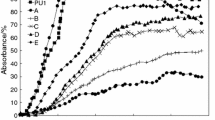Abstract
The introduction of a variety of natural and synthetic cellular polymers into buildings and aircraft has led to a study of the smoke developed by these materials. Smoke density varies widely with exposure conditions and specimen size. The choice of test conditions can have a decisive effect on comparisons of smoke density.
Similar content being viewed by others
References
Los Angeles Fire Department,Operation School Burning (National Fire Protection Association, Boston, 1959).
Los Angeles Fire Department,Operation School Burning No. 2 (National Fire Protection Association, Boston, 1961).
Kingman, F. E. T., Coleman, E. H., and Rasbash, D. J.,Journal of Applied Chemistry (British), Vol. 3, No. 10 (Oct. 1953), pp. 463–468.
Schaffer, E. L. and Eickner, H. W., “Corridor Wall Linings—Effect on Fire Performance,”Fire Technology, Vol. 1, No. 4 (Nov. 1965) pp. 243–255.
Silversides, R. G.,Fire Test Methods—Restraint and Smoke, ASTM Special Technical Publication No. 422 (American Society for Testing and Materials, Philadelphia, June 1966), pp. 125–165.
Fackler, J. B.,Fire Test Methods—Restraint and Smoke, ASTM Special Technical Publication No. 422 (American Society for Testing and Materials, Philadelphia, June 1966), pp. 205–219.
Shern, J. H., “Smokeproof Towers in Center Core Structures,”Fire Technology, Vol. 2, No. 4 (Nov. 1966), pp. 303–307.
McGuire, J. H., “Smoke Movement in Buildings,”Fire Technology, Vol. 3, No. 3 (Aug. 1967), pp. 163–174.
McGuire, J. H., “Control of Smoke in Building Fires,”Fire Technology, Vol. 3, No. 4 (Nov. 1967), pp. 281–290.
Rasbash, D. J., Plastics Institute Transactions and Journal Conference Supplement No. 2 (Jan. 1967), pp. 55–62.
Marcy, J. F., Federal Aviation Agency Technical Report ADS-3 (1964).
Marcy, J. F., “A Symposium: Research to Advance Aircraft Fire Safety; Part I: Interior Material Finishes,”Fire Technology, Vol. 2, No. 4 (Nov. 1966), pp. 263–273.
Gross, D., Loftus, J. J., Lee, T. G., and Gray, V. E., national Bureau of Standards Report No. NA-68-36 (June 1968).
Gross, D., Loftus, J. J., and Robertson, A. F.,Fire Test Methods—Restraint and Smoke, ASTM Special Technical Publication No. 422 (American Society for Testing and Materials, Philadelphia, June 1966), pp. 166–204.
Gaskill, J. R. and Veith, C. R., American Chemical Society, Division of Organic Coatings and Plastics Papers, Vol. 28, No. 1 (April 1968), pp. 282–290.
Rohm and Haas Co., “A Method of Measuring Smoke Density,” NFPAQuarterly, Vol. 57, No. 3 (Jan. 1964), pp. 276–287.
Rarig, F. J. and Bartosic, A. J.,Fire Test Methods—Restraint and Smoke, ASTM Special Technical Publication No. 422 (American Society for Testing and Materials, Philadelphia, June 1966), pp. 106–124.
Einhorn, I. N., Mickelson, R. W., Shah, B., and Craig, R.,Journal of Cellular Plastics, Vol. 4, No. 5 (May 1968), pp. 188–197.
Hilado, C. J.,Industrial & Engineering Chemistry, Product Research & Development, Vol. 7, No. 2 (June 1968), pp. 81–93.
“Method of Test of Surface Burning Characteristics of Building Materials”, NFPA No. 255 (National Fire Protection Association, Boston, 1966).
Bono, J. A. and Breed, B. K., “Study of Smoke Ratings Developed in Standard Fire Tests in Relation to Visual Observations,” Research Bulletin No. 56, April 1965, Underwriters' Laboratory, Inc., Northbrook, Ill.
Bono, J. A. and Breed, B. K., “Smoke Ratings in Relation to Visual Observations—A Study,”Fire Technology, Vol. 2, No. 2 (May 1966), pp. 146–158.
Shern, J. H.,Fire Test Methods—Restraint and Smoke, ASTM Special Technical Publication No. 422 (American Society for Testing and Materials, Philadelphia, June 1966), pp. 93–105.
“Standard Method of Test for Surface Flammability of Materials Using a Radiant Heat Energy Source, ASTM E-162,” ASTMStandards Part 14 (American Society for Testing and Materials, Philadelphia, Nov. 1968), pp. 427–438.
Robertson, A. F., Gross, D., and Loftus, J. J., “A Method for Measuring Surface Flammability of Materials Using a Radiant Energy Source,” ASTMProceedings, American Society for Testing and Materials, Vol. 56, 1956, pp. 1437–1453.
Gross, D., and Loftus, J. J., National Bureau of Standards Report No. 7325, August 1961.
Robertson, A. F., “Surface Flammability Measurements by the Radiant Panel Method (with discussion),” Symposium on Fire Test Methods (1962), (American Society for Testing and Materials, Philadelphia, 1963), pp. 33–46.
Cass, R. A.,Journal of Cellular Plastics, Vol. 3, No. 1 (Jan. 1967), pp. 41–43.
Hilado, C. J.,Flammability Handbook for Plastics (Technomic Publishing Co., Stamford, Conn., 1968).
Building Materials List—1968 (Underwriters' Laboratories, Inc., Chicago, Ill., Jan. 1968).
Additional information
Chemicals and Plastics Union Carbide Corporation
Rights and permissions
About this article
Cite this article
Hilado, C.J. Smoke from cellular polymers. Fire Technol 5, 130–139 (1969). https://doi.org/10.1007/BF02591591
Issue Date:
DOI: https://doi.org/10.1007/BF02591591



